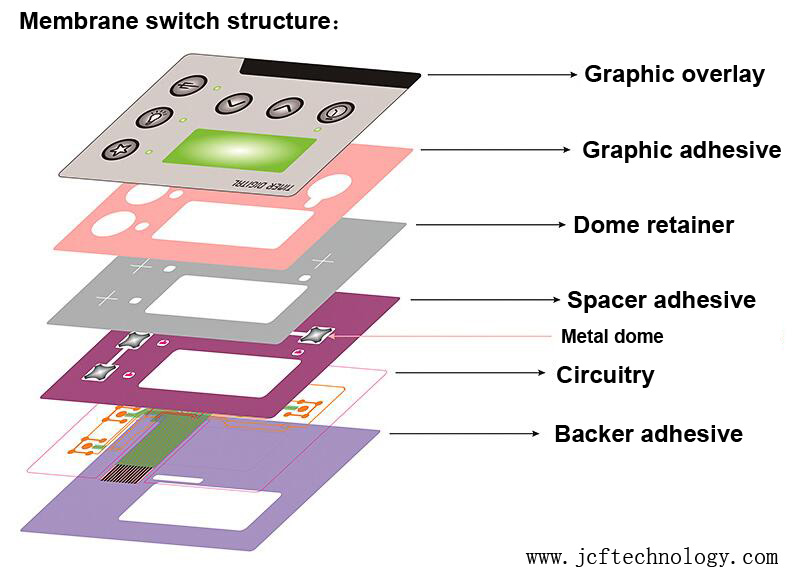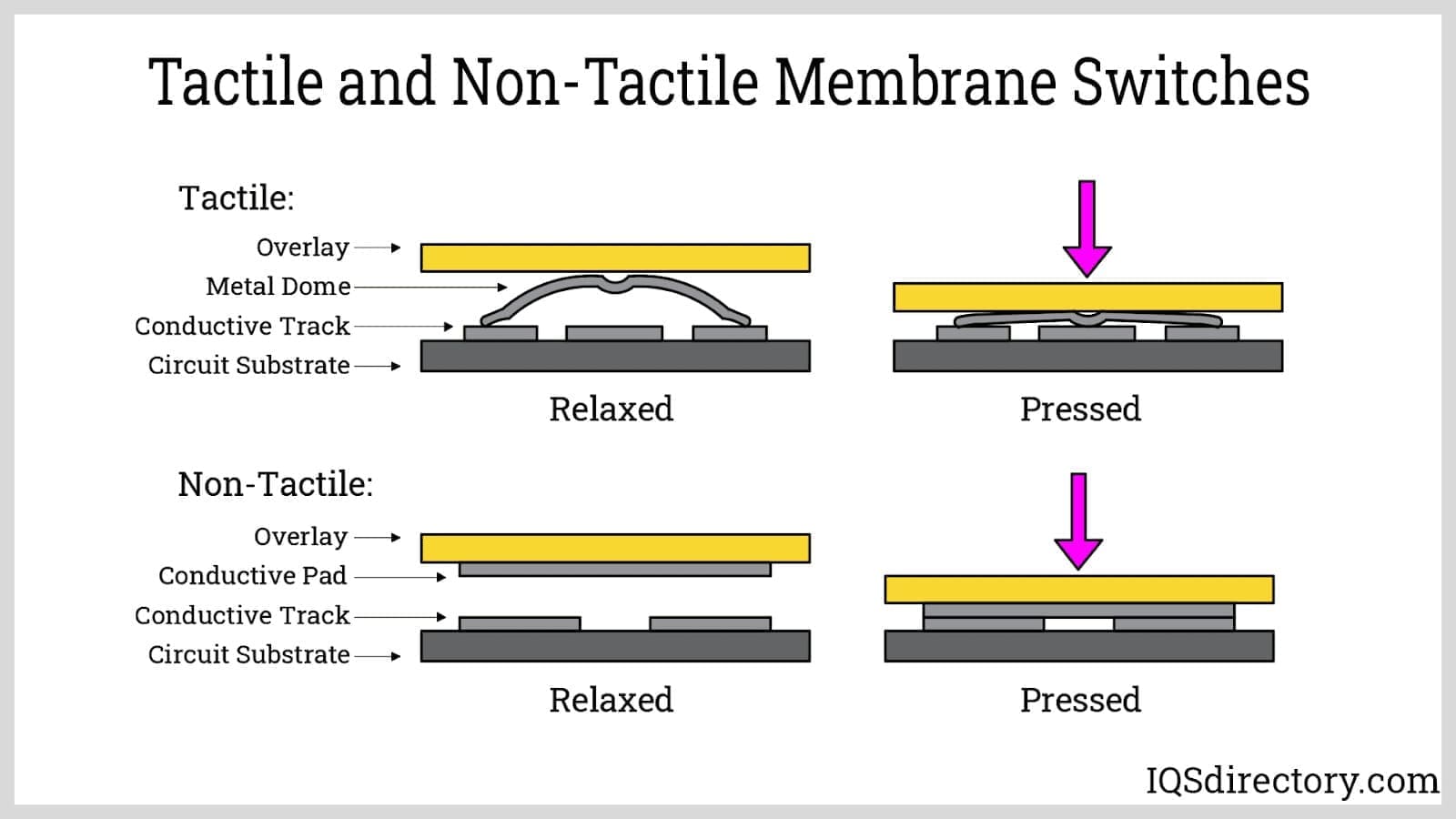Membrane Switch Manufacturer Offering High-Accuracy Engineering Solutions
Exploring the Production Refine of Membrane Switch for Different Industries
The manufacturing procedure of Membrane switches is a complicated venture that requires precision and attention to information. From choosing suitable materials to implementing extensive quality assurance steps, each step plays a vital role in ensuring capability. Different sectors, consisting of automotive and clinical, rely upon these parts for their special applications. Understanding the intricacies of this process reveals considerable insights into just how these switches are produced and their influence across varied industries.
Understanding Membrane Switches: A Review

Secret Materials Used in Membrane Switch Production
In Membrane button production, the option of essential materials significantly influences capability and durability. Conductive products, adhesives, and coatings play vital duties, while substrate option affects general performance and dependability. Recognizing these elements is crucial for enhancing the design and manufacturing of Membrane switches.
Conductive Products Summary
Conductive materials play an essential duty in the performance of Membrane buttons, guaranteeing trustworthy electric connections within the device. Generally utilized products consist of silver, copper, and carbon-based inks, each offering unique advantages. Silver is preferred for its high conductivity and durability, making it suitable for applications needing robust performance. Copper, while a little less conductive than silver, is an economical option usually made use of in printed circuits. Carbon-based inks give a flexible alternative, appropriate for applications where adaptability and lower prices are focused on, although they have actually reduced conductivity compared to steel options. The choice of conductive materials directly influences the general dependability, life-span, and efficiency of the Membrane button, making it a crucial factor to consider in the production process.
Adhesives and Coatings
Adhesives and finishes are necessary elements in the production of Membrane buttons, providing essential bonding and protective homes. These materials guarantee that numerous layers of the switch, consisting of visuals overlays and wiring, adhere securely to one another, enhancing resilience and functionality. Typically used adhesives consist of pressure-sensitive adhesives (PSAs) and epoxy-based solutions, which offer strong attachment and durability. Coatings, such as polyurethane or acrylic, serve to secure against ecological elements, consisting of wetness, abrasion, and chemicals. In addition, finishes can boost responsive feedback and visual allure, adding to the overall customer experience. The selection of appropriate adhesives and finishes is critical for enhancing performance and longevity in diverse applications across different sectors, making sure that Membrane switches meet particular functional needs.
Substrate Choice Aspects
Substratum selection plays an important duty in the manufacturing of Membrane switches, as it significantly affects their total performance and sturdiness. Trick materials such as polyester, polycarbonate, and versatile printed motherboard (FPCBs) are typically made use of for their distinctive residential or commercial properties. Polyester is favored for its cost-effectiveness and resistance to abrasion, making it suitable for applications with high wear. Polycarbonate deals exceptional clearness and impact resistance, perfect for atmospheres calling for high presence. FPCBs offer improved flexibility and are usually made use of in complex styles. The selection of substrate also influences variables like thermal stability, chemical resistance, and simplicity of printing. Ultimately, choosing the proper substratum is crucial for ensuring the performance and long life of Membrane switches over across different markets.
The Layout Refine of Membrane Switches
The design process of Membrane switches is a crucial phase that considerably affects the capability and aesthetics of the end product - membrane switch manufacturer. It begins with defining the certain needs of the application, including measurements, switch format, and tactile feedback preferences. Designers have to think about individual communication, making sure that the switch is instinctive and accessible.Next, products are picked based upon longevity, versatility, and ecological resistance. The assimilation of graphics and branding elements is likewise vital, as it improves visual appeal and interaction. Prototyping permits for iterative testing, enabling adjustments based upon user comments and performance evaluations.Additionally, the design has to make up the electric parts, such as ports and circuits, guaranteeing integrity and convenience of usage. Ultimately, an effective style harmonizes functionality, visual appeals, and customer experience, leading the means for efficient production and durable performance in different industries
Printing Strategies for Membrane Switches
The printing methods used in Membrane switch manufacturing play a crucial function in determining the end product's quality and performance. Display printing uses advantages such as resilience and dynamic color application, while electronic printing technologies supply versatility and precision in layout. Comprehending these approaches can considerably impact the total effectiveness of Membrane buttons in different applications.
Screen Printing Advantages
Countless advantages make screen printing a favored method for creating Membrane switches. This method enables for high-quality, thorough layouts and vivid colors, which are crucial for user interface applications. Screen printing is specifically efficient for using thick ink layers, improving longevity and responsive responses. Furthermore, it provides outstanding bond to various substratums, making certain long life in requiring settings. The procedure is affordable for big manufacturing runs, as it decreases arrangement time and waste. Screen printing supports a large range of inks, including specialty and UV-curable options, making it possible for versatility in layout. Its capacity to generate regular outcomes across multiple devices makes it a dependable option for producers going for top quality and performance in Membrane button production.
Digital Printing Innovations

Innovations in digital printing modern technology are changing the production of Membrane switches, providing suppliers ingenious solutions that enhance design versatility and performance. Digital printing permits for intricate layouts and high-resolution graphics, enabling custom branding and capability without the constraints of traditional techniques. This method reduces configuration times and costs, promoting shorter production runs and marginal waste, making it suitable for businesses with differing demands. In addition, advancements in ink formulas provide far better toughness and attachment, guaranteeing durability in various atmospheres. As markets increasingly look for customized and complicated designs, digital printing sticks out as a vital strategy, establishing a brand-new standard in Membrane switch manufacturing. The combination of these technologies navigate to these guys placements manufacturers to meet developing market needs successfully.
Setting up and Layering of Membrane Switch Parts
Cautious setting up and layering of Membrane button components are necessary to ensuring capability and resilience. This process begins with the accurate alignment of different layers, including the visuals overlay, sticky, circuit layer, and backing material. Each component must be thoroughly placed to preserve electric stability and interface responsiveness.During assembly, conductive traces are related to the circuit layer, usually made from products like polyester or polycarbonate. This layer is vital, as it beams when pressure is used. The glue made use of for bonding these layers is likewise selected for its ability to sustain ecological anxieties while preserving a secure bond.Heat and stress are commonly applied during the setting up process to ascertain that the layers stick appropriately without jeopardizing the functionality of the button. Focus is provided to the side sealing to secure against wetness and contaminants, safeguarding the long life of the Membrane switch in numerous commercial applications.
Quality Assurance Procedures in Membrane Switch Manufacturing
Quality control steps play a vital role in making certain the dependability and efficiency of Membrane switches over following the setting up and layering of their parts. In the production process, several vital evaluations are performed to promote quality requirements. These consist of visual examinations for problems in printing and glue application, as well as practical examinations to validate the responsiveness of each switch.Additionally, environmental screening is executed to evaluate the switches' resilience versus temperature level fluctuations and humidity direct exposure. Producers usually implement statistical process control (copyright) methods to keep an eye on production uniformity, enabling early discovery of anomalies.Furthermore, traceability systems are developed to track elements and materials, making certain responsibility and promoting remembers if required. Calibration of devices and adherence to sector criteria are additionally important to keeping item honesty. Jointly, these quality assurance steps guard the efficiency of Membrane switches over throughout numerous applications, ultimately enhancing customer fulfillment.
Applications of Membrane Switches Over Throughout Different Industries
Membrane switches are made use of throughout a diverse array of industries, showcasing their adaptability and versatility. In the medical market, they provide reputable and waterproof interfaces for tools such as analysis devices and infusion pumps, guaranteeing hygiene and convenience of use. The auto market utilizes Membrane buttons for control panel controls, enabling seamless interaction between the vehicle driver and vehicle systems.In consumer electronics, these buttons are discovered in appliances and portable gadgets, providing a sleek, modern-day aesthetic while boosting performance. Industrial applications also utilize Membrane switches for equipment control panels, where sturdiness and resistance to harsh conditions are essential.Furthermore, the aerospace and defense markets use Membrane switches for cabin instrumentation and communication systems, focusing on integrity and performance under extreme conditions. Overall, Membrane buttons play an essential function in boosting the user experience and functional efficiency throughout various domain names.
Regularly Asked Questions
For how long Does It Require To Make a Membrane Switch?
The production time for a membrane button generally varies from a couple of days to several weeks - membrane switch manufacturer. Aspects affecting this duration include style complexity, material accessibility, and manufacturing quantity, all impacting the general timeline noticeably
What Is the Regular Lifespan of a Membrane Layer Switch?
The common lifespan of a membrane switch generally ranges from 1 to 5 million actuations, relying on factors such as material high quality, ecological conditions, and usage frequency, considerably influencing longevity and overall performance.
Can Membrane Changes Be Personalized for Certain Applications?
Membrane buttons can indeed be customized for particular applications. Their design versatility enables for changes in dimension, form, colors, and graphics, making certain compatibility with one-of-a-kind requirements throughout numerous sectors and enhancing functionality and user experience.

Are Membrane Changes Environmentally Friendly?
The ecological impact of Membrane switches varies. Some products used might not be environment-friendly, while improvements in making processes are significantly concentrating on sustainability, aiming to minimize waste and advertise click here for info recyclable components in their production.
What Are the Usual Failure Modes of Membrane Buttons?
Typical failing modes of Membrane buttons include delamination, sticky failure, deterioration from use, moisture ingress, and electric failures. These problems can significantly impact capability, performance, and life expectancy in various applications across different markets. Membrane switches can be personalized to fit details design requirements, such as size, performance, and shape, making them extremely adaptable.The building and construction commonly entails multiple layers, including a graphic overlay, adhesive, and a circuit layer, which function with each other to produce a smooth individual experience. In Membrane switch manufacturing, the option of crucial products considerably affects performance and sturdiness. The vehicle industry employs Membrane buttons for control panel controls, making it possible for smooth communication in between the motorist and automobile systems.In customer electronics, these switches are found in appliances and Home Page handheld devices, supplying a streamlined, modern aesthetic while boosting capability. Industrial applications likewise take advantage of Membrane changes for machinery control panels, where sturdiness and resistance to severe conditions are essential.Furthermore, the aerospace and defense sectors make use of Membrane switches for cabin instrumentation and interaction systems, prioritizing reliability and efficiency under extreme conditions. Membrane switches can certainly be customized for details applications.